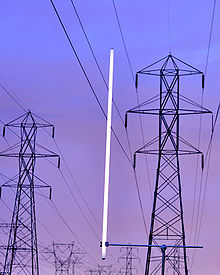User talk:Selladour
Selladour's Sandbox[edit]
Science demonstrations[edit]

Fluorescent lamps can be illuminated by means other than a proper electrical connection. These other methods however result in very dim or very short-lived illumination, and so are seen mostly in science demonstrations. Static electricity or a Van de Graaff generator will cause a lamp to flash momentarily as it discharges a high voltage capacitance. A Tesla coil will pass high frequency current through the tube, and since it has a high voltage as well, the gases within the tube will ionize and emit light. Capacitive coupling with high-voltage power lines can light a lamp continuously at low intensity,[1] depending on the intensity of the electrostatic field.
Also, placing a bulb half way up a two-way radio antenna while transmitting will illuminate the bulb due to the RF energy.
- Interesting picture, but is it a composite? Something about this doesn't quite look right, and I was a little alarmed to see that Photoshop was involved in making this image. Could you explain it a little? Thanks, --Wtshymanski (talk) 13:58, 23 June 2010 (UTC)
Testing[edit]
Hydraulic mortar was not available in ancient China, possibly due to a lack of volcanic ash. Around 500 CE, sticky rice soup was mixed with slaked lime to make an inorganic−organic composite mortar that had more strength and water resistance than lime mortar. [2][3]
References[edit]
- ^ "Richardbox.com at Internet Archive".
- ^ ""Revealing the Ancient Chinese Secret of Sticky Rice Mortar"[[Science Daily]]". Retrieved 23 June 2010.
{{cite web}}: URL–wikilink conflict (help) - ^ Fuwei Yang, Bingjian Zhang, and Qinglin Ma, ‘’ Study of Sticky Rice−Lime Mortar Technology for the Restoration of Historical Masonry Construction’’, Acc. Chem. Res., 2010, 43 (6), pp 936–944
Fluorescent lamp photo[edit]
I am the photographer of the fluorescent lamp glowing under the power lines. I did use Photoshop to crop and sharpen the picture but it is entirely accurate. I shoot in Nikon RAW so I do not use any in camera color correction or sharpening.

I set the equipment up before dusk so I had enough light to focus properly. I originally had the tube (an 8 footer) clamped in the middle but the glow below the clamp was distinctly dimmer so I moved the lamp up for the real shot.

And just for fun, here's a shot of a compact fluorescent glowing. I took this the night before, along with some of the 8' tube hand held. The short exposure required to defeat my inevitable shaking of the lamps required a high ISO that made the photos too grainy for my taste. That's what led to the clamped shots the next night. BTW, the green streak is a lightning bug flying through the scene.

- Wtshymanski, I'm new at this, so please forgive and instruct on any breaches of etiquette. The photographer (my brother) has put the originals above, so I hope you'll agree there were no shenanigans and that it is worth putting the picture back on the fluorescent tube page. The next time you drag your (no doubt) lovely and long suffering bride to the left edge of the middle of nowhere North Dakota to photograph power lines, you gotta bring a fluorescent tube. You can pick it up at the ND Walmart and return it when you are done (you don’t even have to open the package). If you point the tube at the power line like a light saber, it will glow (dimly), if you hold it towards the middle with two hands, it will be dark between your hands but lit beyond them(you are a conductor, so your hands will be at the same potential). The Electric field drops off by 1/(r squared), so if you hold the tube parallel to the wires, it will go out. If you hold the tube tangent to the circumference of a circle centered on the wire, it should also go out. I’m not sure why you’re still sitting here; go get a fluorescent tube and visit your local power lines. You just gotta. Thanks Selladour (talk) 01:53, 24 June 2010 (UTC)
- PS, the CFL only glows visibly when we hold(and ground out) the bottom. I guess it is too small to have a significant change in the electric field unless we put the electrode at zero.
- Thanks for the explanation. What was the clamp made out of? I'm surprised to see so much light below the clamp, which (along with the Photoshop use) made me concerned about the picture. --Wtshymanski (talk) 02:10, 24 June 2010 (UTC)
